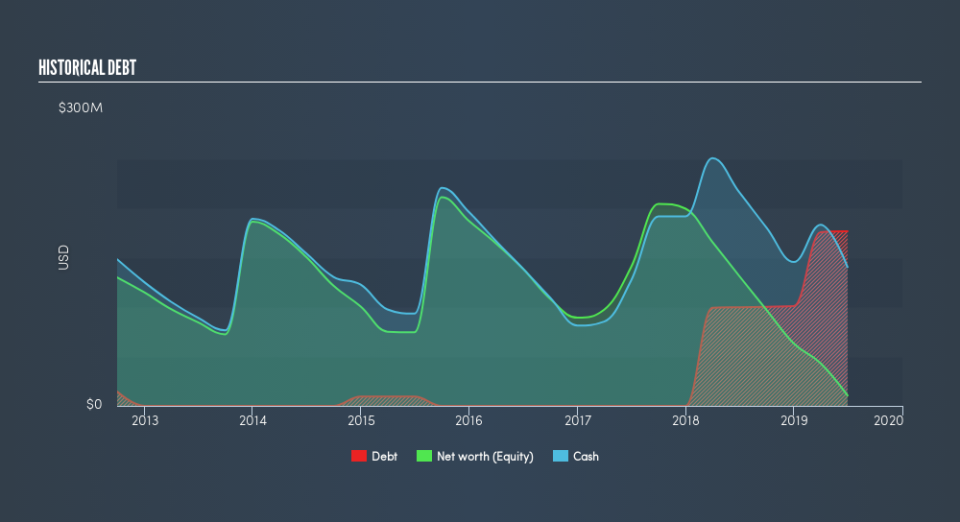We Think Dynavax Technologies (NASDAQ:DVAX) Has A Fair Chunk Of Debt

Legendary fund manager Li Lu (who Charlie Munger backed) once said, 'The biggest investment risk is not the volatility of prices, but whether you will suffer a permanent loss of capital.' So it might be obvious that you need to consider debt, when you think about how risky any given stock is, because too much debt can sink a company. We note that Dynavax Technologies Corporation (NASDAQ:DVAX) does have debt on its balance sheet. But should shareholders be worried about its use of debt?
When Is Debt Dangerous?
Debt and other liabilities become risky for a business when it cannot easily fulfill those obligations, either with free cash flow or by raising capital at an attractive price. In the worst case scenario, a company can go bankrupt if it cannot pay its creditors. However, a more frequent (but still costly) occurrence is where a company must issue shares at bargain-basement prices, permanently diluting shareholders, just to shore up its balance sheet. Of course, plenty of companies use debt to fund growth, without any negative consequences. When we think about a company's use of debt, we first look at cash and debt together.
Check out our latest analysis for Dynavax Technologies
What Is Dynavax Technologies's Debt?
You can click the graphic below for the historical numbers, but it shows that as of June 2019 Dynavax Technologies had US$176.6m of debt, an increase on US$99.8m, over one year. However, it does have US$140.5m in cash offsetting this, leading to net debt of about US$36.1m.
How Healthy Is Dynavax Technologies's Balance Sheet?
We can see from the most recent balance sheet that Dynavax Technologies had liabilities of US$44.6m falling due within a year, and liabilities of US$211.9m due beyond that. Offsetting this, it had US$140.5m in cash and US$7.58m in receivables that were due within 12 months. So its liabilities outweigh the sum of its cash and (near-term) receivables by US$108.4m.
Dynavax Technologies has a market capitalization of US$359.8m, so it could very likely raise cash to ameliorate its balance sheet, if the need arose. But it's clear that we should definitely closely examine whether it can manage its debt without dilution. When analysing debt levels, the balance sheet is the obvious place to start. But it is future earnings, more than anything, that will determine Dynavax Technologies's ability to maintain a healthy balance sheet going forward. So if you're focused on the future you can check out this free report showing analyst profit forecasts.
Over 12 months, Dynavax Technologies reported revenue of US$21m, which is a gain of 1297%. That's virtually the hole-in-one of revenue growth!
Caveat Emptor
While we can certainly savour Dynavax Technologies's tasty revenue growth, its negative earnings before interest and tax (EBIT) leaves a bitter aftertaste. Indeed, it lost a very considerable US$145m at the EBIT level. Considering that alongside the liabilities mentioned above does not give us much confidence that company should be using so much debt. Quite frankly we think the balance sheet is far from match-fit, although it could be improved with time. Another cause for caution is that is bled US$166m in negative free cash flow over the last twelve months. So suffice it to say we consider the stock very risky. When I consider a company to be a bit risky, I think it is responsible to check out whether insiders have been reporting any share sales. Luckily, you can click here ito see our graphic depicting Dynavax Technologies insider transactions.
Of course, if you're the type of investor who prefers buying stocks without the burden of debt, then don't hesitate to discover our exclusive list of net cash growth stocks, today.
We aim to bring you long-term focused research analysis driven by fundamental data. Note that our analysis may not factor in the latest price-sensitive company announcements or qualitative material.
If you spot an error that warrants correction, please contact the editor at editorial-team@simplywallst.com. This article by Simply Wall St is general in nature. It does not constitute a recommendation to buy or sell any stock, and does not take account of your objectives, or your financial situation. Simply Wall St has no position in the stocks mentioned. Thank you for reading.

 Yahoo Finance
Yahoo Finance 
